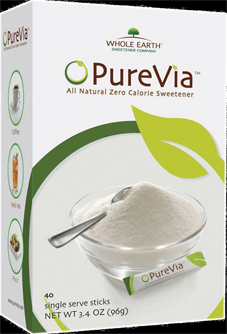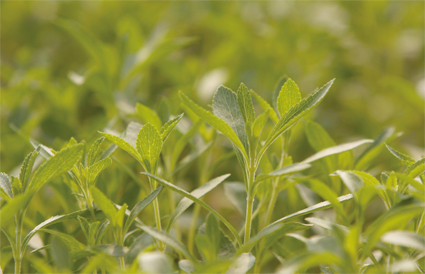 AS A SWEETENER, stevia sounds too good to be true: It is a natural substance that is 300 times sweeter than sugar and yet contains no calories and low glycaemic. For years it has kept a low profile on the shelves of health food stores, sold as a diet dietary supplement because few governments would allow it to be sold as a sweetener. Yet, today, stevia is gaining wide use as an alternative sweetener and analysts predict that it will be a mainstream sugar replacer early in the next decade. At least one market analyst, Mintel, reports that stevia has now surpassed both saccharin and aspartame in terms of dollar sales share and has partially contributed to the 2 per cent decline in sucralose dollar sales compared to the same period in the prior year. A survey by KnowGenix, a business research and growth strategy firm involved in chemical, material and energy practices, finds that there currently is an overall positive feeling about market growth in the stevia market. The survey shows that the food and beverage sector will occupy over 65% of the total stevia market share. Respondents also believe that Stevia sweeteners will capture over 50% of aspartame and sucralose's market shares. KnowGenix reports that despite this optimism, the top two main concerns amongst suppliers are flavour and supply. Such is the interest in this plant-based sweetener that conferences worldwide on stevia have attracted larger and larger participation, especially after the US Food and Drug Administration gave stevia its approval in December 2008. Stevia been used since the 1970s in Japan, but use accelerated after the US agency cleared the use of a stevia extract called rebaudioside A (Reb-A). Today, the extract is also permitted for use in foods and beverages in Argentina, Australia, Brazil, China, Columbia, France, Japan, Korea, Malaysia, Mexico, New Zealand, Peru, Russia, Switzerland, Taiwan, Turkey, Ukraine, Uruguay, and Paraguay, where its use originated. Stevia suppliers are optimistic that approval in the European Union will be announced by mid-2010. Whilst the F&B industry's interest has been piqued, there is still a lot to learn about stevia - and certainly from the Asian consumer's point of view, brands of stevia haven't reached the recognition level of 'Equal' (aspartame) or of 'Splenda' (sucralose). In fact, as one recent study shows, consumers are confused about how low-calorie sweeteners and whether they are beneficial for weight loss and whether they are safe. The results of the survey of over 2000 consumers carried out by YouGov on behalf of the British Nutrition Foundation indicates that the role and benefits of low calorie sweeteners need to be communicated clearly to the general public.
AS A SWEETENER, stevia sounds too good to be true: It is a natural substance that is 300 times sweeter than sugar and yet contains no calories and low glycaemic. For years it has kept a low profile on the shelves of health food stores, sold as a diet dietary supplement because few governments would allow it to be sold as a sweetener. Yet, today, stevia is gaining wide use as an alternative sweetener and analysts predict that it will be a mainstream sugar replacer early in the next decade. At least one market analyst, Mintel, reports that stevia has now surpassed both saccharin and aspartame in terms of dollar sales share and has partially contributed to the 2 per cent decline in sucralose dollar sales compared to the same period in the prior year. A survey by KnowGenix, a business research and growth strategy firm involved in chemical, material and energy practices, finds that there currently is an overall positive feeling about market growth in the stevia market. The survey shows that the food and beverage sector will occupy over 65% of the total stevia market share. Respondents also believe that Stevia sweeteners will capture over 50% of aspartame and sucralose's market shares. KnowGenix reports that despite this optimism, the top two main concerns amongst suppliers are flavour and supply. Such is the interest in this plant-based sweetener that conferences worldwide on stevia have attracted larger and larger participation, especially after the US Food and Drug Administration gave stevia its approval in December 2008. Stevia been used since the 1970s in Japan, but use accelerated after the US agency cleared the use of a stevia extract called rebaudioside A (Reb-A). Today, the extract is also permitted for use in foods and beverages in Argentina, Australia, Brazil, China, Columbia, France, Japan, Korea, Malaysia, Mexico, New Zealand, Peru, Russia, Switzerland, Taiwan, Turkey, Ukraine, Uruguay, and Paraguay, where its use originated. Stevia suppliers are optimistic that approval in the European Union will be announced by mid-2010. Whilst the F&B industry's interest has been piqued, there is still a lot to learn about stevia - and certainly from the Asian consumer's point of view, brands of stevia haven't reached the recognition level of 'Equal' (aspartame) or of 'Splenda' (sucralose). In fact, as one recent study shows, consumers are confused about how low-calorie sweeteners and whether they are beneficial for weight loss and whether they are safe. The results of the survey of over 2000 consumers carried out by YouGov on behalf of the British Nutrition Foundation indicates that the role and benefits of low calorie sweeteners need to be communicated clearly to the general public. With its 'natural' label, stevia is poised to overtake other sweeteners in the food and beverage segment
Clearly, there is even more work when it comes to communicating what stevia is to consumers. The source Stevia is derived from the South American shrub in the Asteraceae family native to portions of northeastern Paraguay. The plant (Stevia rebaudiana Bertoni) has been grown, harvested and used in South America as a sweetener in foods and beverages for more than 200 years. Steviol glycosides are the sweet components of the stevia leaf. There are various kinds of steviol glycosides, but the two most abundant types are stevioside and rebaudioside A. The plant material between the veins of the stevia leaf contains the sweet compounds; the bitterness is found in the veins. Each leaf of Paraguayan stevia contains 9 to 13 per cent stevioside, which is about 300 times sweeter than cane sugar. One-half teaspoon of powdered white stevia contains less than one calorie and less than a half gram of carbohydrates. Reb-A is the best-tasting of the steviol glycoKD VIII Elite High
The source Stevia is derived from the South American shrub in the Asteraceae family native to portions of northeastern Paraguay. The plant (Stevia rebaudiana Bertoni) has been grown, harvested and used in South America as a sweetener in foods and beverages for more than 200 years. Steviol glycosides are the sweet components of the stevia leaf. There are various kinds of steviol glycosides, but the two most abundant types are stevioside and rebaudioside A. The plant material between the veins of the stevia leaf contains the sweet compounds; the bitterness is found in the veins. Each leaf of Paraguayan stevia contains 9 to 13 per cent stevioside, which is about 300 times sweeter than cane sugar. One-half teaspoon of powdered white stevia contains less than one calorie and less than a half gram of carbohydrates. Reb-A is the best-tasting of the steviol glycoKD VIII Elite High













